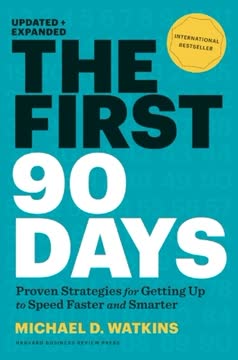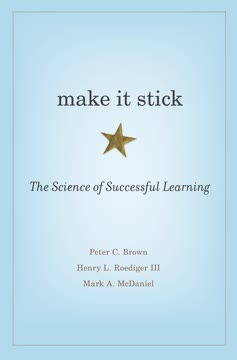Key Takeaways
1. Training is both an art and a science, requiring a balance of research-based methods and creative delivery
"Know the science; apply your art."
Scientific foundation. Training effectiveness relies on a solid foundation of research-based methods and principles. This includes understanding cognitive science, adult learning theory, and instructional design models like ADDIE. These provide a framework for creating effective learning experiences that align with how people actually learn and retain information.
Artistic application. While science provides the structure, the art of training lies in the creative application of these principles. This involves adapting methods to suit different learners, contexts, and content. Effective trainers use storytelling, visual aids, interactive activities, and their own personality to bring the content to life and make it engaging and memorable.
Balancing act. The key to success is finding the right balance between science and art. Too much focus on scientific principles can lead to dry, rigid training, while overemphasis on creativity might sacrifice learning effectiveness. The best trainers seamlessly blend both aspects, using research-backed methods as a foundation for their creative delivery.
2. Adult learning principles are fundamental to effective training design and delivery
"Adults have a need to know why they should learn something before investing time in a learning event."
Malcolm Knowles' principles. Understanding and applying adult learning principles is crucial for effective training. These include:
- Respect for learners' self-concept and experience
- Relevance and immediate application of learning
- Problem-centered approach
- Internal motivation
Application in design. Incorporate these principles by:
- Clearly communicating the purpose and benefits of training
- Using real-world examples and case studies
- Allowing for self-directed learning and participant input
- Providing opportunities for reflection and application
Delivery considerations. During training, facilitate rather than lecture. Encourage discussion, peer learning, and hands-on practice. Create a safe, respectful environment where adults feel comfortable sharing their experiences and asking questions.
3. The 70-20-10 framework guides holistic learning and development strategies
"The 70-20-10 framework is a holistic approach and is powerful when everything is working together."
Framework components:
- 70%: Experiential learning (on-the-job experiences)
- 20%: Social learning (learning from others)
- 10%: Formal learning (structured courses and programs)
Beyond the classroom. Recognize that most learning happens outside formal training settings. Design strategies that support and leverage on-the-job learning experiences and social interactions. This might include mentoring programs, job rotations, stretch assignments, and collaborative projects.
Integration is key. While the percentages are guidelines, not strict rules, the power lies in integrating all three components. Formal training should prepare learners for on-the-job application and encourage peer learning. Follow-up activities and manager support are crucial for reinforcing and applying new skills in the workplace.
4. Technology enhances training but doesn't replace sound instructional design
"Social media, e-learning, and technology that we haven't even heard of yet can make learning more fun, less expensive, and more immediate than in the past."
Leveraging technology. Embrace tools like learning management systems, virtual classrooms, mobile learning apps, and social learning platforms to enhance accessibility, engagement, and personalization of training. These can provide just-in-time learning, facilitate collaboration, and offer new ways to practice and reinforce skills.
Instructional design first. Technology should support learning objectives, not drive them. Start with sound instructional design principles, then choose appropriate technologies to enhance delivery and effectiveness. Avoid the trap of using technology for its own sake.
Blended approaches. Often, the most effective training combines technology-enhanced elements with face-to-face interaction. This allows for the benefits of both digital and in-person learning experiences, catering to different learning preferences and needs.
5. Preparation is key to successful training delivery and learner engagement
"The best thing you can do for your participants is prepare for their success."
Thorough preparation. Invest significant time in preparing content, materials, activities, and the learning environment. This includes:
- Mastering the content
- Anticipating questions and potential challenges
- Preparing visual aids and handouts
- Setting up the physical or virtual space
Learner-centered approach. Research your audience in advance. Understand their backgrounds, expectations, and potential barriers to learning. Tailor your content and delivery to their needs and context.
Creating the right environment. Preparation extends to creating a safe, welcoming learning environment. This involves:
- Arriving early to set up and greet participants
- Establishing ground rules and expectations
- Planning icebreakers and engagement activities
- Ensuring all necessary materials and technology are ready and functioning
6. Aligning training with organizational needs ensures relevance and impact
"Organizations whose learning strategy is aligned to organizational requirements are more agile and competitive."
Strategic alignment. Training should directly support organizational goals and strategies. This requires:
- Understanding the business context and challenges
- Collaborating with stakeholders to identify critical skill gaps
- Linking learning objectives to performance outcomes
Needs assessment. Conduct thorough needs assessments at organizational, task, and individual levels to ensure training addresses real performance gaps and business needs. This data-driven approach helps justify training investments and focus efforts where they'll have the most impact.
Continuous communication. Maintain ongoing dialogue with business leaders, managers, and learners to stay aligned with evolving needs and demonstrate the value of training initiatives. Be prepared to adapt programs as organizational priorities shift.
7. Evaluation is critical for demonstrating training effectiveness and driving continuous improvement
"Evaluation efforts should address what is happening in a training program as much as whether that program is making any difference."
Kirkpatrick's Four Levels. Use this model as a framework for comprehensive evaluation:
- Reaction: Learner satisfaction
- Learning: Knowledge and skill acquisition
- Behavior: On-the-job application
- Results: Business impact
Beyond smile sheets. While learner reactions are important, focus on higher-level outcomes. Measure actual learning through assessments, observe behavior change on the job, and track relevant business metrics to demonstrate impact.
Continuous improvement. Use evaluation data to refine and improve training programs. Identify what's working well and areas for enhancement. Share results with stakeholders to demonstrate value and gain support for future initiatives.
8. Trainers must continuously develop their own competence, commitment, and confidence
"What sets average trainers apart from experts? Behaviors, skills, and actions that you might not expect."
Competence development. Stay current with industry trends, adult learning research, and instructional technologies. Seek opportunities to expand your skills through formal training, certifications, conferences, and self-directed learning.
Commitment to excellence. Demonstrate passion for your craft and commitment to learner success. Continuously seek feedback, reflect on your practice, and strive for improvement. Be willing to adapt and innovate to meet changing learner and organizational needs.
Building confidence. Confidence comes from mastery and experience. Practice your skills regularly, seek challenging assignments, and learn from both successes and failures. Develop a growth mindset that embraces learning opportunities and sees challenges as chances to improve.
Last updated:
FAQ
What's The Art and Science of Training about?
- Dual Nature of Training: The book explores training as both an art and a science, emphasizing the need to understand both to create effective learning experiences.
- Research and Practice: It combines the latest research on learning theories with practical advice for trainers and facilitators.
- Holistic Approach: Elaine Biech advocates for integrating scientific principles with creative techniques to enhance learner engagement and retention.
Why should I read The Art and Science of Training?
- Expert Insights: The book is filled with insights from experienced professionals, making it valuable for both new and seasoned trainers.
- Practical Application: It provides actionable strategies and tools that can be immediately applied in training sessions.
- Comprehensive Coverage: Covers a wide range of topics, from adult learning principles to technology use in training.
What are the key takeaways of The Art and Science of Training?
- Balance of Art and Science: Effective training requires a balance between scientific research and creative delivery methods.
- Importance of Preparation: Preparation is crucial, including understanding the audience and practicing the material.
- Focus on Learners: Training should be centered around learners' needs, motivations, and experiences.
What are the best quotes from The Art and Science of Training and what do they mean?
- “It’s all about the learner.”: Training should prioritize learners' needs and experiences.
- “Proper preparation and practice prevent poor performance.”: Highlights the importance of thorough preparation and rehearsal.
- “Training is not a cost. It’s an investment.”: Encourages viewing training as a strategic investment in employee development.
How does Elaine Biech define the art and science of training?
- Art Defined: Creative aspects like storytelling and engagement techniques.
- Science Defined: Research-based principles and theories for effective instructional design.
- Interconnection: Both art and science are essential for impactful training experiences.
What is the ADDIE model mentioned in The Art and Science of Training?
- Instructional Design Framework: ADDIE stands for Analyze, Design, Develop, Implement, and Evaluate.
- Continuous Improvement: The model is cyclical, allowing for ongoing refinement of training programs.
- Practical Application: Trainers are encouraged to adapt the model to their specific contexts.
What are some adult learning principles discussed in The Art and Science of Training?
- Need to Know: Adults need to understand why learning is important.
- Self-Directed Learning: Adults prefer to take responsibility for their own learning experiences.
- Experience Matters: Adult learners bring valuable experience that should be utilized in training.
How does The Art and Science of Training address the use of technology in training?
- Integration of Technology: Importance of incorporating technology to enhance engagement and accessibility.
- E-Learning Effectiveness: Online learning can be as effective as traditional methods when designed properly.
- Future Trends: Explores emerging technologies like virtual reality and mobile learning.
What is the 70-20-10 model mentioned in The Art and Science of Training?
- Learning Framework: Suggests 70% of learning occurs through experiences, 20% through social interactions, and 10% through formal training.
- Holistic Development: Emphasizes integrating various learning methods for comprehensive development.
- Practical Application: Encourages leveraging this model for effective learning environments.
How can I create a conducive learning environment according to The Art and Science of Training?
- Physical Setup: Ensure the space is organized, comfortable, and equipped with necessary technology.
- Positive Atmosphere: Foster a welcoming environment where learners feel safe to share.
- Engagement Strategies: Use interactive activities to keep learners engaged.
How does The Art and Science of Training define effective training?
- Alignment with Goals: Training should align with organizational objectives and address performance gaps.
- Engagement and Participation: Actively engages participants with interactive activities and discussions.
- Evaluation and Feedback: Continuous evaluation to assess effectiveness and improve future sessions.
What role does evaluation play in training according to The Art and Science of Training?
- Measuring Effectiveness: Essential for assessing if learning objectives were met and the impact on performance.
- Continuous Improvement: Provides feedback for enhancing future training sessions.
- Stakeholder Accountability: Demonstrates the value of training to stakeholders, justifying the investment.
Review Summary
The Art and Science of Training receives mostly positive reviews, praised for its comprehensive approach to training design and delivery. Readers appreciate the practical tips, adult learning theory insights, and emphasis on both art and science in training. Many find it valuable for new and experienced trainers alike. The book covers topics like needs assessment, instructional methods, and evaluation. Some readers note its relevance to teaching and professional development. However, a few criticize the writing style and perceived contradictions.
Similar Books










Download PDF
Download EPUB
.epub digital book format is ideal for reading ebooks on phones, tablets, and e-readers.




